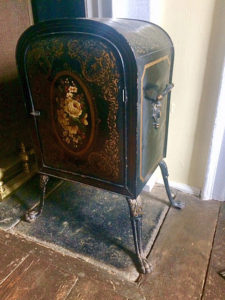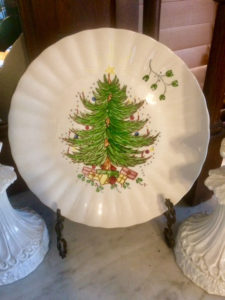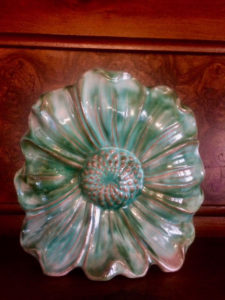by Lisa C. Cantwell
There were no reader questions this month, so I’d like to share three pieces that I either noticed in a home, inherited, or found in an antique market.
I hope you enjoyed learning about vintage items and antiques through this column. Due to decreasing submissions of reader’s questions, this is the last “Trinket or Treasure” article. Please look for a new column in January on fascinating travel destinations, some regional and some across the pond, but all within the realm of possibility.
 The first item that caught my attention was a pretty, decorated metal box, perched on four legs by a hearth at a historic home where I was a guest, recently.
The first item that caught my attention was a pretty, decorated metal box, perched on four legs by a hearth at a historic home where I was a guest, recently.
Its light weight and handles suggested that it was portable and could be moved about the room. I first thought it was a space heater. Further inspection revealed three shelves inside, giving away its purpose: this was a fireplace food warming oven. This tole-painted tin oven has aged well, as research dates it to the 1850s. The food could be placed directly on the shelves or in pans until ready to be plated. The strong cast iron legs and feet could withstand hot coals, but not a roaring fire. The little oven measures 26.5” high, 13” wide, and 10.5” deep. This example is in excellent condition, as evidenced by the preserved design. A similar oven sold on an auction website for $225 earlier this year. Look for similar treasures in historic homes—you may solve a mystery, too!
 Just in time for the holidays, I inherited several hand-painted Christmas tree plates.
Just in time for the holidays, I inherited several hand-painted Christmas tree plates.
The identifying mark on the back of the plate read: “Blue Ridge, Southern Potteries, Inc., Hand Painted – Underglaze.” I was surprised to learn that Southern Potteries was the largest producer of hand-painted china in the United States until the mid-20th century. The pottery establishment was begun in 1916 in Erwin, Tennessee, to establish commercial business for the Carolina, Clinchfield & Ohio railroad line. By 1920, the company incorporated and thousands of “Blue Ridge” themed patterns were produced to include flowers, landscapes, animals, and holiday motifs. By WWII, production of the china reached seventeen million pieces per year. There were eleven showrooms, from New York City to San Francisco. Even though the factory closed by 1957 due to bankruptcy, the pottery is still in demand. In fact, there is a club devoted to fans of the pottery, and every year during the town of Erwin’s apple festival, thousands converge to celebrate, trade, and buy everything “Blue Ridge”! The Christmas tree plate ranges in price from $18.95 to $62.00 on a popular online auction site. My plates are not for sale, but for celebrating. In fact, Christmas dinner this year will be served on the hand-painted surface of an American treasure!
 Lastly, at an antique mall in Frederick County, I noticed a booth with shelves and shelves of vases with beautiful glazes. Being a southerner, the magnolia blossom vase with its burnished, teal, green glaze was of interest. It measured 7.5” tall and 8.5” high, and the stamp on its base read: “Stangl, USA, 3413.” Johann Martin Stangl, an artist and entrepreneur, began his career working in pottery in 1910. After working for several well-known houses of pottery, to include Fulper and Haeger, he formed his own company in 1929. Vases, dinnerware, and bird figurines were the prominent products of Stangl’s venture. He died in 1972, and the line was bought by Pfaltzgraff Pottery. This vase was made in 1941 and is from the “Terra Rose” collection. It’s described by sellers as a rose, daisy, poppy, sunflower, cosmos, or magnolia blossom. Fairly common, but not always in the best of shape, this glazed pottery vase also comes in a blue color. I found it priced at $24.00 to $84.00 on internet antique sale sites.
Lastly, at an antique mall in Frederick County, I noticed a booth with shelves and shelves of vases with beautiful glazes. Being a southerner, the magnolia blossom vase with its burnished, teal, green glaze was of interest. It measured 7.5” tall and 8.5” high, and the stamp on its base read: “Stangl, USA, 3413.” Johann Martin Stangl, an artist and entrepreneur, began his career working in pottery in 1910. After working for several well-known houses of pottery, to include Fulper and Haeger, he formed his own company in 1929. Vases, dinnerware, and bird figurines were the prominent products of Stangl’s venture. He died in 1972, and the line was bought by Pfaltzgraff Pottery. This vase was made in 1941 and is from the “Terra Rose” collection. It’s described by sellers as a rose, daisy, poppy, sunflower, cosmos, or magnolia blossom. Fairly common, but not always in the best of shape, this glazed pottery vase also comes in a blue color. I found it priced at $24.00 to $84.00 on internet antique sale sites.

